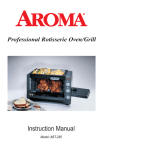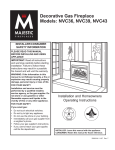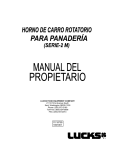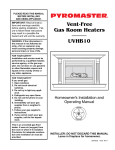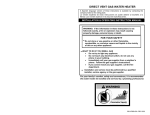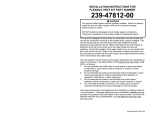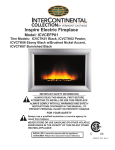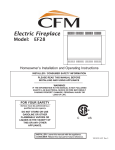Download CFM Corporation PVS-1 User's Manual
Transcript
Power Venting System Model: PVS-1 for use with Decorative Gas Appliance Models: NVC33VN/VP, NVC36VN/VP, NVC39VN/VP, NVC43VN/VP INSTALLER/CONSUMER SAFETY INFORMATION PLEASE READ THIS MANUAL BEFORE INSTALLING AND USING APPLIANCE WARNING: If the information in this manual is not followed exactly, a fire or explosion may result causing property damage, personal injury or loss of life. FOR YOUR SAFETY Installation and service must be performed by a qualified installer, service agency, or the gas supplier. Do not store or use gasoline or other flammable vapors and liquids in the vicinity of this or any other appliance. FOR YOUR SAFETY If you smell gas: • Do not try to light any appliance. • Do not touch any electric switch; do not use any phone in your building. • Immediately call your gas supplier from your neighbors phone. Follow the gas supplier’s instructions. • If you cannot reach your gas supplier, call the fire department. • Open windows / Extinguish all flames. Homeowner’s Installation & Operating Manual DE S I GN CE CERTIFIED RTIFI E D PLEASE KEEP THIS MANUAL FOR FUTURE REFERENCE 51810 1/06 Rev. 2 Majestic® Fireplaces Power Venting System Installation Instructions General information and instructions for the power vent system model No. PVS-1. NOTE: The PVS-1 will only work in conjunction with a VN Gas Valve P/N 57588 or VP Gas Valve P/N 57587. 1. This power vent system must be installed by a qualified installer in accordance with all applicable local codes and with the current installation codes for gas burning appliances CSA-B149.1 in Canada or ANSI Z223.1/NFPA 54 in the U.S.A. Electrical connections and grounding must be in accordance with the Canadian Electrical Code, C22.1 Part 1 and in U.S.A., National Electrical Code ANSI/ NFPA70 and/or local codes where applicable. 2. This device must be installed by a qualified professional installer in accordance with these instructions. If improperly installed, a hazardous condition such as an explosion or carbon monoxide poison could result. 3. The Power Vent System #PVS-1 has been certified by CSA to be installed as a component part and is for use only with fireplace models listed in the front page of this manual. Certification is cancelled if used with other than listed products. 4. Plan the vent system so that code required distances are maintained from plumbing and wiring. 5. The Power Venter motor shaft must be mounted horizontally to ensure proper operation of the fan pressure proving switch and to prevent motor bearing wear. 6. Flue gas temperatures must not exceed 470ºF at Power Venter inlet. Ambient temperature must not exceed 104ºF. 7. Disconnect power supply when making wiring connections or when working around the fan blade and motor. Failure to do so may result in severe personal injury and equipment damage. 8. Make certain the power source is adequate for the fan motor requirements. Do not add the Power Venter to a circuit where the total load is unknown. 9. This Power Venter System #PVS-1 shall be installed with Sound Reducer Kit Nos. SR 4 for fireplaces with a 4” (102 mm) flue collars and SR 5 for fireplaces with 5” (127 mm) flue collars. See INSTALLATION RESTRICTIONS Page 5. Power Vent System Parts and Description 1. Fan Assembly - comes complete with 6’ (1.8 m) power cord for plugging into a standard house receptacle. The system is completely pre-wired and includes the pressure switch and 24 volt transformer. 2 2. 24 Volt Wiring Harness - a 40’ (12m) wiring harness with plug-in connectors. Eliminates costly time consuming electrical installations. 3. Vent Terminal - the device which exhausts flue gases into the atmosphere. 4. Fan Mounting Bracket - to secure the fan in a vibration-free mode so as to reduce vibration through the pipes. 5. Flex-Connector - an additional device to reduce vibration and noise through the pipes. It is mounted to the negative inlet side of the fan. 6. Approved 4” (102 mm) diameter insulated aluminum flex liner, 4” (102 mm) diameter B-Vent* or 4” (102 mm) diameter single wall metal vent connector. 7. Assorted clamps, connectors and wall mounting brackets. General Venting Information Always consult your local codes and authorities, in the absence of such codes, follow the current installation codes for gas burning appliances CSA-B149.1 in Canada or ANSI Z223.1/NFPA 54 in the US. 1. Clearance to Combustible Materials: • 1” (25 mm) for insulated single wall vent or flexible vent pipe. • 6” (152 mm) for single wall fan housing. • 1” (25 mm) for fan motor. • 1” (25 mm) for B-Vent.* • 6” (152 mm) for single wall vent or flexible vent pipe. * B-Vent can only be used on the negative side of the power venter - between the appliance and the power venter - and insulated flexible liner or single wall vent on the outlet side of the power venter. To reduce fan noise or condensation, CFM Corporation recommends all venting pipes be insulated with a minimum of 1” (25 mm) fiberglass insulation. 2. Total allowable system length is 100’ (30 m) of straight pipe. Minimum allowable system length is 5’ (1.5 m). NOTE: Deduct 10’ (3 m) for each 90° elbow and 5’ (1.5 m) for each 45° elbow. Example: An installation requires 30’ (9 m) of straight pipe with 45° and three (3) 90° elbow. Straight pipe 30’ (9 m) 45º Elbow (1) 5’ (1.5 m) 90º Elbow (3) 30’ (9 m) TOTAL 65’ (19.5 m) Total equivalent pipe length = 65’ (19.5 m) 51810 Majestic® Fireplaces Power Venting System 3. Vent System Termination Before installing Power Venter, determine location of vent system termination. 4. Location of the Fan To keep the noise level to a minimum, the fan should be located as far from the appliance as possible. A storage cupboard, or laundry area are preferred locations. Permanent access for inspection and servicing must be provided. 5. All portions of the vent system under positive pressure during operation (on the outlet side of the Power Venter) shall be designed and installed so as to prevent leakage of flue or vent gases into a building. General Code Requirements Power Venter Specifications Electrical Motor voltage .................................... 115 Control Circuit Voltage ........................24 Hz ........................................................60 RPM ................................................3000 Watts ...................................................95 Amps ................................................1.26 Thermal Protection ............................ Yes Mechanical Shaded Pole Motor ........................... Yes Int. Fan Cooled ................................. yes Shaft Diameter (inch) ........................313 Bearings .............................. Sleeve Type The exit terminal shall be so arranged that flue gases are not directed so as to jeopardize the safety of people, overheat combustible structures or enter buildings, and that proper clearances are maintained. Always consult your local codes and authorities. In the absence of such codes follow the current installation codes for gas burning appliances CSA-B149.1 in Canada or ANSI Z223.1/NFPA 54 in the US. Also see Diagram A - Vent Termination Locations. 51810 3 Majestic® Fireplaces Power Venting System General Venting Information - Termination Location INSIDE CORNER DETAIL V D H A V E L V B V F C B ����� ������ ��� ��� V V VENT TERMINATION B V �������� �� B CFM145a G B V V ����� ������ J G X B I A X AIR SUPPLY INLET M C = Clearance to permanently closed window D = Vertical clearance to ventilated soffit located above the terminal within a horizontal distance of 2’ (610mm) from the center line of the terminal E = Clearance to unventilated soffit F = Clearance to outside corner G = Clearance to inside corner (see next page) H = Clearance to each inside of center line extended above meter/regulator assembly I = Clearance to service regulator vent outlet J = Clearance to nonmechanical air supply inlet to building or the combustion air inlet to any other appliances K X A V V AREA WHERE TERMINAL IS NOT PERMITTED Canadian Installations1 A = Clearance above grade, veranda, porch, deck, or balcony B = Clearance to window or door that may be opened V G US Installations2 12” (30cm) CFM145a 12” (30cm) 6” < 10,000Btuh (3kW), 12” (30cm) for appliances > 10,000 Btuh (3kW) and < 100,000 Btuh (30kW), 36” (91cm) for appliances > 100,000 Btuh (30kW) 12” (305mm) recommended to prevent window condensation 6” (15cm) for appliances < 10,000 Btuh (3kW), 9” (23cm) for appliances > 10,000 Btuh (3kW) and < 50,000 Btuh (15kW), 12” (30cm) for appliances > 50,000 Btuh (15kW) 12” (305mm) recommended to prevent window condensation 18” (458mm) 18” (458mm) 12” (305mm) see next page see next page 3’ (91cm) within a height of 15’ (4.6 m) above the meter/regulator assembly 3’ (91cm) 6” (15cm) for appliances < 10,000 Btuh (3kW), 12” (30cm) for appliances > 10,000 Btuh (3kW) and < 100,000 Btuh (30kW), 36” (91cm) for appliances > 100,000 Btuh (30kW) DV Termin Location 5/01/01 Rev. 12/05/01 (15cm) sta for appliances K = Clearance to a mechanical air supply inlet 6’ (1.83m) L = Clearance above paved sidewalk or paved driveway located on public property M = Clearance under veranda, porch, deck or balcony 7’ (2.13m)† 12” (305mm) see next page see next page 3’ (91cm) within a height of 15’ (4.6m) above the meter/regulator assy 3’ (91cm) 6” (15cm) for appliances < 10,000 Btuh (3kW), 9” (23cm) for appliances > 10,000 Btuh (3kW) and < 50,000 Btuh (15kW), 12” (30cm) for appliances > 50,000 Btuh (15kW) 3’ (91cm) above if within 10’ (3m) horizontally 7’ (2.13m)† 12” (30cm)‡ 12” (30cm)‡ 1 In accordance with the current CSA-B149 Installation Codes 2 In accordance with the current ANSI Z223.1/NFPA 54 National Fuel Gas Codes † A vent shall not terminate directly above a sidewalk or paved driveway which is located between two (2) single family dwellings and serves both dwellings ‡ only permitted if veranda, porch, deck or balcony is fully open on a minimum two (2) sides beneath the floor: NOTE: 1. Local codes or regulations may require different clearances. 2. The special venting system used on Direct Vent appliances are certified as part of the appliance, with clearances tested and ap proved by the listing agency. 4 51810 Majestic® Fireplaces Power Venting System Horizontal Discharge Installation Vertical Discharge 1. Slip Sound Reducer into flue collar and press on to fireplace top. 2. Fasten Sound Reducer to fireplace top with four (4) sheet metal screws supplied. 3. Continue with the power venter installation as per instructions supplied with same. 4” (102 mm) Insulated Flue Liner Oil Holes Motor Shaft Vertical Sound Reducer Sheet Metal Screws Fireplace Top Incorrect FP1419 Fig. 3 The Power Venter must be mounted with motor shaft horizontal. 3. Power Venter housing in single wall a 6” (152 mm) clearance must be maintained. (Fig. 4) FP1419 motor views 11/25/03 djt FP1417 Combustible Material 6" (152mm) Minimum Fig. 1 Secure sound reducer to fireplace top with four (4) sheet metal screws. Sound Reducer Kit SR6 FP1417 1. Although the Power Venter can be installed anypowervent where in the exhaust system, it is best if it is installed system of the vent system as as close to the termination view possible to obtainfront optimal appliance efficiency and to 11/24/03 djt 2) prevent flue gas leakage. (Fig. Combustible Material Installation Restrictions Power Venter 6" (152mm) Minimum NOTE: 6” (152mm) maximum clearance from combustible must be maintained. Vent Support Hangers Spaced 36” (914mm) on Horizontal Run 6" (152mm) Minimum Fireplace Combustible Material FP1420 Fig. 4 Minimum clearance. Anti-Vibration Sleeve FP1418 Fig. 2 It is best to install Power Venter as close to the termination as possible. 2. Power Venter must be mounted with motor shaft horizontal to ensure proper operation of the fan proving FP1418 switch and to prevent motor bearing wear. (Fig. 3) power vent location 11/24/03 djt 51810 4. Allow for a minimum of 18” (457mm) vertical rise off the top of the appliance before the vent makes a 90° FP1420 Minimum elbow to the horizontal. (Fig.clearance 5) 11/25/03 djt 5. Vent pipe transitions, where necessary, should be gradually tapered. (Fig. 6) 6. Power Venter to vent pipe connections and all joints on the outlet side of the Power Venter must be sealed with high temperature silicone sealant or aluminum vent pipe tape to prevent flue gas leakage. (Fig. 7) 7. The vent terminal must not be more than 20’ (6m) below the appliance’s flue outlet. 5 Majestic® Fireplaces Power Venting System 18” (457mm) Minimum FP1421 Fig. 5 An 18” (457mm) minimum vertical rise is necessary before a 90° elbow. FP1421 Min. vertical rise 11/25/03 djt Incorrect Correct FP1423 4. Install optional sound reducer (Model SR5 or SR4) onto fireplace. See Installation Instructions packaged with sound reducer. 5. Mount Power Venter NOTE: It is best to locate the fan near the vent terminal. However, if such a location is not suitable, the fan can be installed anywhere within the vent system. a. Remove vibration isolation mount and retain the nut from the parts bag and install. Install on Power Venter as shown in diagram. Next install flexible duct piece and outlet collar using four (4) screws to fasten. b. To prevent vibration, securely support Power Venter from ceiling or joist with Power Venter bracket. (Fig. 8) c. By using 1” (25 mm) bracket, clearance to fan is maintained at 1” (25 mm). The addition of the 6” (152 mm) bracket, maintains a 6” (152 mm) clearance to combustibles. Vertical Mounting Fig. 6 Vent pipe transitions should be gradually tapered. Ceiling Power Venter Negative Pressure FP1423 Positive Pressure pipe transitions 11/25/03 djt All seams on the positive side of power venter to be sealed with high temperature silicone sealant. Power Venter Bracket 6” (152 mm) Bracket 1” (25 mm) Bracket Vibration Isolation Mounts Discharge Fan Power Venter FP1424 Horizontal Mounting Discharge FP1422 Fig. 7 Vent pipe connections and all joints on the outlet side of the power venter must be sealed with high temperature sealant. FP1422 pipe transitions Installation 11/25/03 djt 1. Cut 6¹⁄₄” (159mm) diameter hole through outside wall - see General Code Requirements for proper location. 2. Install vent terminal. Fasten from outside with four (4) screws and caulk around flange edge. 3. Locate fireplace and fasten to floor as shown in fireplace manual. 6 Wall or Wall Studs FP1424 vertical mounting 11/25/03 djt Fan Power Venter Bracket FP1425 Fig. 8 Power venter mounting options. FP1425 horizontal mounting 11/25/03 djt 51810 Majestic® Fireplaces Power Venting System 6. Measure distance between fireplace’s flue outlet (top of Sound Reducer) and fan inlet. Cut flexible duct and insulate with insulation sleeve sections using noise cone for ease of mounting. Please note that wherever possible use continuous length pipe without joints. 7. Apply silicone at both ends, and attach flex pipe to collars. Secure with clamps (provided). For additional reinforcement, it is recommended that three (3) sheet metal screws be used at each joint to prevent pipe from accidentally separating. 8. If fan is located at vent terminal, connect it by first sealing the joints with silicone. Again use three (3) sheet metal screws for each joint. 9. Seal all joints with aluminum vent pipe tape and cover with insulation. Joints between fan and vent terminal must be absolutely air and water tight to prevent flue gas or condensation leakage. 10. Support venting duct with plumber’s strap (supplied by installer). On horizontal runs support vent pipe every 36” (914mm) to prevent it from sagging. 11. Enclose venting system, if necessary leaving at least 1” (25 mm) clearance between insulation and combustible materials and 6” (152 mm) between fan housing and combustibles. Electrical Wiring Electrical connections and grounding must be in accordance with the Canadian Electrical Code, C22.1 Part 1 and in U.S.A., National Electrical Code ANSI/NFPA70 and/or local codes where applicable. Operation Sequence of 24 VAC Controlled Appliance When Power Vent Switch is activated, its closure completes the 24 VAC electrical circuit from the appliance transformer through the switch to the Power Venter relay. The 24 volts applied to the relay coil bring in the 115 volt power to the motor. The air movement generated by the Power Venter closes the Fan Proving Switch contacts which allows the switch signal to reach the 24 volt burner control. The Fan Proving Switch actually becomes the burner controller and will allow the appliance to operate only when the Power Venter is operating. WARNING: All 120 volt wiring must comply with applicable codes and ordinances. The optional power venter Model PVS-1 is equipped with a plug-in cord and an electric knockout. When unit is wired directly the cord must be removed. Install 24 Volt wiring harness. Simply plug in connector at fan electrical box, slide connectors onto gas valve operator and connect to power switch or if applicable to thermostat. Refer to Figure 9. Be sure to keep wires away from heated areas, within the fireplace route wires along gas line. Black L1 White L2 To Fan* 115 / 1 / 60 Black N/O Relay Power Venter Motor Black White G 115V 24V Thermostat Blue Blue *If optional fan and/or power venter is used, wire electrical system as shown in diagram. (Dotted Line) Wiring connections must be made within junction box of power venter and optional fan. Transformer 20 VA Fan Prover Gas Valve Yellow Relay Coil Orange FP1426 Fig. 9 Typical wiring, 24 VAC control. 51810 7 Majestic® Fireplaces Power Venting System Operation and Checking the Draft 1. Insofar as is practical, close all doors, windows and air inlets to the building. Turn on all exhaust fans (range hood, bathroom exhaust, etc.) so they will operate at maximum speed. 2. Place appliance into operation. See fireplace manual for gas start up information. Once pilot has been lit and gas valve has been set open, activate power switch, or where applicable, adjust thermostat so the appliance will operate continuously. At this point the fan will start up and once air flow has been proven the main burner will start. 3. After allowing appliance to operate for five (5) minutes, test for spillage at the draft hood relief opening or at fireplace front opening. Checking the Draft. Allow the vent connected gas utilization equipment to operate for several minutes. Then check to see that the combustion products are going up the chimney or gas vent properly, by passing a lighted match or taper around the edge of the relief opening of the draft hood. If the chimney or gas vent is drawing properly, the smoke from the match flame will be drawn into the draft hood or opening. If smoke is not drawn in, then the combustion products are escaping from the relief opening into the room. Under these conditions, the equipment must not be operated until proper adjustments or repairs are made to provide adequate draft through the chimney or gas vent. 4. Next, turn on all other fuel-burning appliances within the same room so they will operate at their full input. Repeat Step C above, checking the draft on each appliance. 5. The Air-Flow Adjustment on the Power Venter is factory set for maximum air flow. Operating a properly sized Power Venter at maximum setting will assure that combustion gases are safely removed to the outside. If the Power Venter has excess venting capacity than what is required for this application, operating the Power Venter with the Air-Flow Adjustment at the maximum setting may draw more dilution air than necessary. The Air-Flow Adjustment may be set by use of a combustion analyzer, inclined manometer or draft gauge. Alternatively, the Air-Flow adjustment can be set using a smoke candle or taper, as follows: a. With exhaust fans operating, air inlets closed and all appliances firing (as instructed above), hold lighted match or taper around the edge of the relief opening of the draft hood or fireplace opening. 8 b. Set Air-Flow Adjustment by loosening locknut and turning rod handle. CAUTION: HANDLE MAY BE HOT, use pliers to move handle. Position of rod handle on outside of Power Venter housing indicates position of Air-Flow Adjustment inside housing. c. Using pliers, move handle towards minimum draft setting until spillage is detected at relief opening, then re-open Adjustment just enough to eliminate spillage. d. Lock Adjustment at desired setting by tightening locknut. e. Return doors, windows exhaust fans and fireplace dampers to their previous condition of use. f. Turn off appliances started in Step 4 above. Damper Closed Damper Open FP1427 Fig. 10 Adjustable damper control. FP1427 Maintenance damper The Power Venters must be inspected 11/25/03 djt semi-annually. Points of inspection are: 1. Motor - Motor must rotate freely. Oil every six months of operation with four (4) drops of SAE 20 oil. 2. Wheel - Wheel must be clean of soot, ash or any other coating which inhibits rotation or air flow. Remove all foreign material from vent system before operation. 3. Pressure Switch - Pressure Switch must operate freely. Verify proper operation by observing Operation Sequence at least every six months. 51810 Majestic® Fireplaces Power Venting System Pressure Switch Power Venter Motor Leads Heyco Adapter Bushing White Heyco Adapter Bushing Green #4 White #1 Switch On 1/2" Off re e n Motor L1 L1 Gas Valve Blue #3 Red #2 Bl ac L2 Green/Yellow Stripe R ed k Grn White Black N/O Blue Comm Black 5 Vibration Isolation Field Installed 4 Power Venter Junction Box Red White G Timer/Relay Control Yellow Black 24 VAC White Yellow 115 VAC White/Red Stripe 20VA Transformer Optional location for vibration isolator Power Venter Housing CFM Corporation reserves the right to make changes in design, materials, specifications, prices and discontinue colors and products at any time, without notice. Power Venter Part List Mounting Bracket 1” Mounting Bracket 6” Hose Clamp Motor Assembly, Power Vent Switch, Wall Vibration Insulator Plate Wall Switch Pressure Switch Timer Relay/Post Purge Transformer 24 Volt Sound Reducer (SR6) 51810 50543 49552 51875 51867 51842 50545 51843 52921 52901 10001694 49770 (Fig. 1) 9 Majestic® Fireplaces Power Venting System 10 51810 Majestic® Fireplaces Power Venting System 51810 11 CFM Corporation 2695 Meadowvale Blvd. • Mississauga, Ontario, Canada L5N 8A3 800-525-1898 • www.cfmcorp.com












